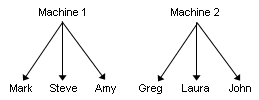Crossed
Nested
Two factors are crossed when each level of one factor occurs in combination with each level of the other factor.
Two factors are nested when the levels of one factor are similar but not identical, and each occurs in combination with different levels of another factor.
For example, if you use crossed factors in your experiment, the same three operators would evaluate surface finish from both machines.
For example, if Machine 1 is in Galveston and Machine 2 is in Baton Rouge, each machine will have different operators.

